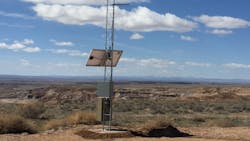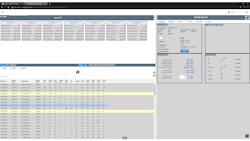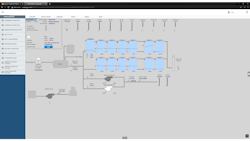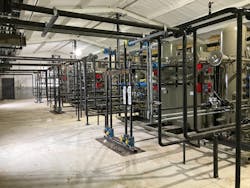A powerful, flexible system for supervisory control and data acquisition (SCADA) transformed upstream oil and gas operations for KODA Resources. KODA is leveraging modern SCADA, MQTT and other technologies to attain better access to data and more efficient operations in two fields — one of which has approximately 1,000 wells producing both oil and natural gas.
KODA Resources is a Denver-based company focused on the acquisition and development of oil and gas properties in the Rocky Mountain region. The company produces from its two assets: the Uintah basin of northeastern Utah and the Williston Basin in northwestern North Dakota. The Uintah field (also known as Red Wash) has produced since the 1950s and has a large variety of lift types, field equipment and automation equipment. The Williston field is a smaller oil-producing field with more modern equipment.
As the software platform for this project, KODA chose Ignition by Inductive Automation. It is an industrial application platform with tools for building solutions in SCADA, human-machine interface (HMI) and the industrial internet of things (IIoT).
While the smaller Williston field was brought into the project later, the initial project was for the much larger Red Wash field. “The project was needed to replace a legacy poll/response SCADA system,” said Evan Rynearson, SCADA engineer for KODA Resources. “The Red Wash field has approximately 1,000 wells, which are run on a variety of RTU and PLC platforms. The old servers and software were out of warranty and support. The solution was to develop an IIOT-ready SCADA system on virtual machines that would support MQTT and our desire to use data to drive the business.”
Solving multiple problems
KODA quickly built a web- and mobile-based platform that integrates operations from both fields. Data, alarms, reports and more all come through one system with approximately 300,000 tags. The project solved many problems, with several modern elements working together. The solution includes Ignition Perspective, which provides strong mobile and design capabilities for SCADA. The SCADA screens use high-performance graphics, which help operators absorb critical information as quickly as possible. There is a unified namespace for easier data access across all activities. There is also MQTT, a lightweight messaging protocol with numerous advantages. And there is Sparkplug B, an open-source software specification that provides MQTT clients the framework to easily integrate data from applications, sensors, devices and gateways.
“This project created a future-ready IIOT system that supports legacy SCADA equipment,” said Rynearson. “Two things stand out. The first is from an admin perspective, adopting the Sparkplug B standards into a unified namespace; this allowed for rapid, repeatable and sustainable developments throughout the entire enterprise. The second is the usability. High-performance HMI standards allow operators to quickly navigate through their routes and see what happened, is happening, and is projected to happen. This allows each operator to manage upwards of 100 wells, covering countless miles, as efficiently and proactively as possible.”
KODA now has more data than ever before — and it is using that data to make more improvements. “We continue to develop the system, including a mobile solution and connecting more business systems,” said Rynearson. “With this, we are looping the operation into the business and the business decisions straight back into the operation, which gives us endless possibilities for improvement.”
Time to upgrade
“The old system had a legacy version of GE IGS, which buffered data between the polling system, field PLCs and the HMI,” said Rynearson. “This approach was slow, hard to understand and required various approaches for multiple devices in the field. The legacy GE iFIX HMI was extremely slow, inefficient, and built on old standards that were no longer relevant and difficult to comprehend for new employees.”
The old polling engine was built by a software company that has been out of business for more than five years and has not offered any support or upgrades since. That just was not sufficient for a system that is critical to upstream oil and gas, which needs both real-time and historical data. The historical data includes electronic flow management (EFM) records for production, accounting and finance, plus records for gas plunger applications that help with operations optimization.
In addition to these problems, the biggest issue was that KODA wanted to develop an MQTT-driven system, but did not have the budget to replace or add on to 850 field devices.
Modern technologies, fast improvements
The six old physical servers were replaced with three new virtual machines. “This provided greater flexibility in size and location, along with improved performance,” said Rynearson. “It gave us a lot more confidence in our servers.”
Autosol Communication Manager (ACM) replaced the legacy poll/response system as a starting point to cover all legacy RTUs that required EFM and plunger records to be captured. The new ACM polling system is a big improvement. The communication percentage has increased from the legacy system and data reliability has increased exponentially.
The old poll/response field devices do not support MQTT or lend themselves to a standard namespace. “So, we added Ignition Edge on top of our poll/response server,” said Rynearson. “That converts all that data to MQTT. Now we have a system that’s built on a unified namespace, with MQTT — which supports the legacy equipment while also paving the way for the future.”
KODA developed an MQTT-based system by putting Edge with Cirrus Link’s MQTT Transmission Module on the same server as ACM. This enabled putting all the tags in the unified namespace, allowing KODA to complete the project in six months, instead of having to update every device in the field to support MQTT. This design allowed KODA to enable MQTT devices without operators even noticing a change — other than faster data access.
The new web-based HMI brought improved speed. The high-performance graphics helped operators understand the data more quickly and sped up the training process for new operators. KODA found the screen-building to be fast and easy, with simple processes for connecting the database, tag data and historical data. “This system has pushed us along in digital transformation,” said Rynearson. “It’s eliminated the need for emailing daily reports, by making them real-time dashboards and tables. And they can be saved if needed.”
Mobile and more
In the legacy system, operators had to click three times to get into the details of each well, wasting time and losing efficiency. KODA fixed that with the software’s table component and docking function. The new screen allows operators to get a high-level overview, with the ability to click through wells while the dock shows the details for each well. What used to be three clicks is now one click per well. “Operators really like the quick navigation and the web-based nature of it,” said Rynearson. “It allows operators to scroll through multiple wells on their routes in half the time it took them in the old system.”
The new SCADA system also gave KODA more mobile capabilities. KODA built a mobile application that is used by executives and managers, from operations to finance. It is also used by field operations groups.
Another benefit is the way objects are updated. The legacy SCADA system required the same site to be built in the field, the RTU, the SCADA system and every system downstream from that. For KODA, the unified namespace and MQTT solved that. MQTT Engine from Cirrus Link Solutions builds tags automatically within the SCADA system. When a new device or object is published from the field, a script runs and builds it in the object database. From there, anyone can assign that object to attributes like route, well type and other factors — and the setup is complete. “This results in much more efficiency in building and commissioning field devices,” said Rynearson. “It also means much less dependency on so many people throughout the organization. And it gives us a huge amount of repeatability from site-to-site in the field, to site-to-site in the enterprise.”
The new system also fixed an issue with email notifications. Previously, as people would go on vacations or need to cover routes for co-workers, they would need to call in to the SCADA team in order to make sure the right emails were going to the right people for alarms and other information. To solve this, KODA built a screen that allows users to assign and remove themselves from different callout notification groups. It is a much smoother process now, and it’s easier for operators to make sure they receive the notifications they need.
Alarm response is also aided by the new high-performance graphics. “The flat graphics and bright colors that relate to standard alarm conditions can drive efficiencies in diagnosing what’s happening on location,” said Rynearson.
KODA Resources knew what it wanted and found the technologies that could meet its needs in a cost-effective way. “I could not be more pleased,” said Rynearson. “We’re very happy with the level of results we’ve been able to achieve.”
Jim Meyers is Communications Manager at Inductive Automation, creator of the Ignition industrial application platform for SCADA, HMI, MES and IIoT.
Inductive Automation





